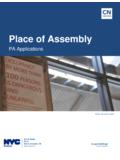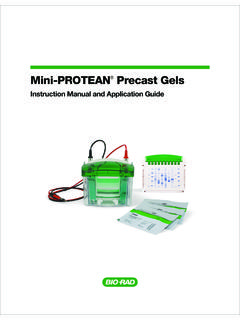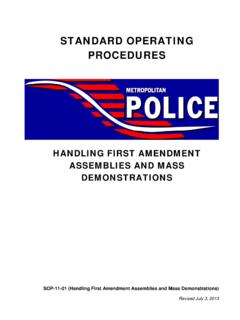Transcription of Hascon assembly instructions - Slipstream Hover …
1 4801 Van Cleave St. Indianapolis, IN 46226 Hascon Fan assembly instructions Overview General info: The Hascon fan is a versatile unit capable of functioning under a wide range of conditions. In the majority of cases, your fan will arrive assembled, pitched, and ready to use right out of the box. This article covers the assembly and re-pitching of a 6 blade fan in a 9 blade hub. This fan shown in the photos is being set up for a Scat with a custom engine; however the procedure is the same regardless of the application or fan model. Fan speed and engine RPM: A hovercraft fan must be pitched to absorb a desired amount of power at a given RPM. In most cases, this is set to the maximum output of the engine. For example, if you have Scat with a Rotax 503 that makes 52 horsepower at 6500 RPM with a 2:1 reduction ratio then the fan must be set to absorb 52 horsepower at 3250 RPM.
2 If there is too little pitch, the engine will rev over its 6500 redline RPM. If there is too much pitch, the engine will not be able to reach 6500 RPM. For this reason, it is essential to have a tachometer when setting up a new fan. Our Tiny-Tach s are perfect for this due to their very low cost and simple installation. Pitch: If you are simply adjusting a fan, you can make minor pitch changes as needed based on RPM. If you are making a major change such as a new engine, new reduction ratio, etc, call Slipstream and we can calculate the pitch required for you. Work Area: There are many small parts inside of a fan assembly . Be sure to work in a clean area and be prepared for the small pitching balls to come out when disassembling a fan. They can be easily lost. Tools required: -10mm sockets and/or open end wrenches for bolts - Flat screwdriver and mallet for splitting hub - Fine felt tip permanent magic marker - A cordless drill with a socket drive attachment is handy for removing bolts, but not essential.
3 Be sure not to over tighten the small bolts. Page 2 of 6 Disassembly: 1. Set the fan on a clean, flat surface so that no small parts get lost. 2. If your fan came factory assembled, it may have balancing washers installed. Look for any bolts that have extra washers installed under them. Mark these locations. Use your magic marker to number each blade and its corresponding socket on the hub. You ll want to reassemble the fan with the blades in the same location to preserve the factory balance. If your fan originally arrived disassembled, you can skip this step. 3. Remove all bolts. 4. Use a flat screwdriver and a mallet to separate the hub halves. It should take only a few gentle taps. Be prepared for the pitching balls to fall out when you do this. assembly : 1. Lay out all parts on a clean, flat surface.
4 Page 3 of 6 2. Look at the end of the blade socket and find the pitch you need. In this example we are going to use 35 degrees. 3. place the pitching ball in the hub notch that corresponds to the blade notch you want. The 4 notches in the hub and the blade should always be aligned. Here we ve chosen the 35 degree notch. Page 4 of 6 4. Carefully place the blade socket into the bottom hub half on top of the pitching ball. Be careful to keep everything lined up. Once the blade is seated, you can twist it back and forth slightly to ensure it is properly locked in place on the pitching ball. 5. Repeat steps 3 and 4 for all remaining blades. place socket plugs in empty sockets as needed. 6. place the other hub half on top of the assembly and squeeze together by hand. Be careful to keep all the pieces in place .
5 Page 5 of 6 7. place two bolts in opposite sides to squeeze the hub halves together. 8. Add the remaining bolts around the outer perimeter. Bolts should be snug, but do not overtighten. 9. When all perimeter bolts are in place , set the fan down on a flat surface. The edge of all blades should touch the surface equally. This check ensures that all blades are set to the same pitch. If any blade does not contact the flat surface equally, disassemble the fan and start over to correct the mistake. 10. If all looks good, add the inner ring of bolts to complete assembly . Note that some fans (like the one in this example) use the inner bolt circle as the mounting bolt pattern. In this case, simply mount the fan in the hovercraft using the appropriate bolts. 11. Use common sense to determine the mounting direction.
6 Some hubs have a stamp on them that states engine side . IGNORE THIS ON HOVERCRAFT INSTALLATIONS. It may or may not be correct. You can determine the direction of rotation by looking at the blades. There is much more curvature on the trailing edge. The INLET side of the fan (top side on a lift fan, front side on a thrust fan) has Hascon Wing embossed near the root of the blade. The OUTPUT side of the fan (bottom on a lift fan, rear on a thrust fan) has the blade style, HVP#BS for example, embossed near the root of the blade. If you have any questions or concerns, feel free to email We ll be happy to assist you with your installation. Page 6 of 6 Shaft Installation instructions Most Hascon fans are flange installations meaning they have a machined bolt pattern that mates with an existing hub.
7 On some hovercraft, primarily direct drive lift fans or homebuilt hovercraft, the fan may need to be installed on a shaft utilizing a QD bushing. 1. The bushing must perfectly match the shaft size. It should be snug and somewhat difficult to get on and off the shaft. This is before it's tightened or inserted into the hub. If it's not, you may have the wrong size. 2. Some new motors are now come with 25mm shaft which is very close to a 1" shaft but is NOT interchangeable. If your 1" bushing slides over the shaft easily but has a small amount of side to side play you may have a 25mm shaft. 3. Everything must be PERFECTLY CLEAN. The shaft, the bushing ID, the bushing OD, the taper inside the hub, the keyway, the key. If you have any surface rust, clean it off with a scratch pad and WD-40 or other rust remover.
8 Clean all parts thoroughly with solvent such as lacquer thinner or alcohol. This is a precision machine fit; any dirt or grit can keep parts from seating. Clean also means burr-free. If you have any imperfections on your shaft, GENTLY file or sand smooth by hand. Remove as little material as possible. This is not a power tool job. 4. Check that your key is clean and fits snugly. Insert the key in the shaft keyway where the bushing will be located. Tap it down tightly using a mallet or dead blow hammer. Do NOT use anything steel. 5. You can now start assembly . Normally the bushing goes on first, but this will depend on what kind if installation you have. If you cannot get the bushing over the shaft and/or key, wedge a flat screwdriver into the split on the bushing. Do this gently near the outside of the bushing and be careful not to gouge anything.
9 You can crack the bushing if you spread it too far. The bushing should easily slide on with the screwdriver in place . 6. Remove the screwdriver, if used and slide the hub over the bushing. Apply a drop of loc-tite to your bolt thread. Insert bolts using the hub s through holes and finger tighten into the bushing s threaded holes. Tighten the key s set screw if you have one. 7. Before torqueing bolts, check fan fitment to verify hub position on the shaft. Adjust if necessary. Ensure key stays in bushing slot. 8. TORQUE properly according to the specs in the bushing box. Treat it like a cylinder head. Tighten each bolt a small amount, 1/4 turn max, then go to the next bolt. Keep going around the circle until each bolt meets specified torque without turning 9. Lastly, tap around the outside of the hub with a rubber mallet or dead blow hammer.
10 Not hard, just enough to jiggle things, then recheck torque. Often, this will help "seat" the hub and bushing allowing slightly more turn on the bolts. 10. Install the fan on the hub.




